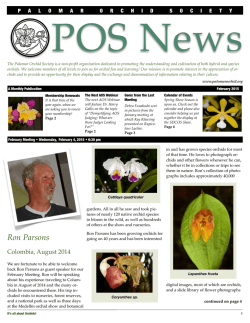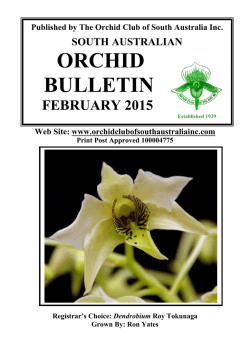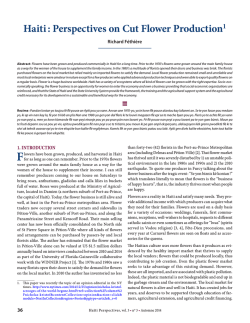
THE NEMOS NEWS - Orchid Societies Council of Victoria Inc
THE NEMOS NEWS February 2015. Issue no. 263 The monthly newsletter of the North East Melbourne Orchid Society Inc. President: Michael Coker Secretary: Glenda Warren Editor: Brian Milligan ([email protected]) NEMOS meets on the third Monday of each month at the Marwal Centre, 9-11 Marwal Avenue, Balwyn North (Mel. 46B3). Culture Corner, the early session for new growers, commences at 7.15 pm. The main meeting begins at 8.00 pm. Visitors are welcome. THE NEXT MEETING NEMOS member Gordon Young will present the main Item of the Evening, a talk on How We Grow Our Orchids. Gordon and his wife Pam have grown a wide range of orchids over many years, so there will be something of interest for everyone. In Culture Corner Alan Hope will talk about the Indoor Culture of Phalaenopsis. PRESIDENT’S REPORT - FEBRUARY 2015 Dear NEMOS Members, Your Committee is planning guest speakers for 2015 – if there is a topic you would like to hear more about, please let me or Brian Milligan know. We try to have a range of topics and new guest speakers to maintain extra interest in our meetings. It has come to our attention that a neighbour of The Marwal Centre has complained a number of times about noise as we leave the monthly meeting venue. The managers of The Marwal Centre are very much on our side on this issue – they recognise that we have been there for many years, and we aren’t usually there very late, or very noisy for that matter. Nonetheless – according to Council regulations, we must vacate the premises by 10.00 pm. Therefore – we either need to have shorter meetings or maybe start them a little earlier. Let’s have a discussion at the February meeting about how best to deal with this matter. As I mentioned at the January meeting – John Skews will be gallivanting around the world for both our winter and spring shows! I really can’t complain – because that’s usually what I do, Editor: Brian Milligan Page 1 and Kay Skews has had to put up with John devoting so much time to NEMOS over the years that, at the least, she deserves some more of John’s time in 2015! One of the impacts this will have on our shows is with prize cards. If any members want prize cards printed – we will certainly make them for those members, but without John & Kay to print them, we will only make them for members who let us know that they want them. On 15 February 2015 the OSCOV Panel will decide the OSCOV Victorian Orchids of the Year. Some of our members have plants in the running – so best wishes for everyone! Let’s hope we have some winners at NEMOS. I have prepared a general talk for beginners on orchids. This is designed to be presented to local social/gardening clubs that meet near orchid clubs in Melbourne and elsewhere in Victoria, to promote our hobby and maybe get some new members. I don’t know of many such groups around North Balwyn (or adjoining or even nearby suburbs) so I’m asking our members to let me know who we should contact to make the arrangements. I’ll ask you at our next meeting. Bye for now, see you in February. MJC SOME ORCHIDS AT MJC’s IN JANUARY Cool/Cold-growing orchids. Masdevallia John Tomaschke ‘Lou Reed’. I have only recently discovered how to grow Masdevallias better – I have traditionally kept them too hot, but they seem to very much enjoy my new house #5. This plant came from Royale Orchids in NSW about 6 years ago. It has been in flower for about 4 months. Epidendrum Pacific Sparkler. This is a good example of a crucifix orchid. It was bred by a famous breeder of reed-stem Epidendrums, Jim Rose of Cal-Orchid in Santa Barbara, about 12 years ago. These orchids can be propagated by THE NEMOS NEWS: February 2015 planting a section of stem about 10 cm long into bark. Thecostele alata Epi. Pacific Sparkler Lycaste macrophylla. My plant came from a flask purchased by Dieter Weise about three years ago. It’s a native of Peru, Ecuador and surrounding countries. Like most Lycastes, it produces multiple flowers per bulb. Paphiopedilum Rolfei ‘Vampira’ is a primary hybrid between P. rothschildianum and P. bellatulum. I purchased the plant from Nicky Zurcher about 3 years ago. It’s still a small plant, and carries only 2 flowers on the stem but I’m hoping for more next year. In my opinion, it’s a beautiful slipper! Paph. Rolfei ‘Vampira’ Lyc. macrophylla Warm/hot-growing orchids. Vanda Ken Kone ‘Alexandra’. I purchased this hot-growing orchid from Castle Creek Orchids about 5 years ago. It received an HCC/OSCOV in 2012. I was hoping for an AD because of its distinctive markings but I can’t complain about the HCC. I would like to bring it to a meeting but my Vanilla planifolia has grown many roots into its pot – and I’m reluctant to disturb the Vanilla before it flowers (if ever)! Paphiopedilum IANTHA STAGE by Michael Coker My plant of Paphiopedilum Iantha Stage was purchased from Castle Creek about 6 years ago. My research indicates that ‘Iantha’ is Greek for ‘violet-coloured flower’ and the hybrid was registered by Mr Stage of Oregon in the USA in 1973. The plant has never flowered for me until this year. A primary hybrid, with the slow-growing multi-floral Paph. rothschildianum as one parent, and it’s not surprising that it takes a while to flower. The other parent is Paph. sukhakulii – a single-flowered species. My plant has 4 stems – each with 2 flowers, but one of the buds damped-off when it was very small. Four stems are quite uncommon on a fairly small plant of this hybrid, so I was very pleased with this flowering. Vanda Ken Kone Thecostele alata. This curious species is found in a number of south-east Asian countries. It’s a sequential flowerer whose stem lasts for about 3 months. Randall Robinson tells me that it’s very closely related to the genus Cymbidium, so I will try to breed it with a few cymbidiums in the next few weeks. Editor: Brian Milligan MICHAEL’S CHOICE* The editor has asked Michael to write in detail about one of his orchids each month Page 2 It has been said that “the flowers superficially look like enormous P. sukhakulii, retaining the distinctive petal spots and maculations of that parent. However, P. rothschildianum bestows the flowers with much larger and boldly-striped dorsals”. THE NEMOS NEWS: February 2015 are commonly grown. However, many more zygopetalum hybrids are available, together with an increasing number of inter-generic hybrids produced by hybridising with related genera, such as Pabstia (Colax) and Promenaea. These hybrids often flower twice yearly. P. Iantha Stage The plant was awarded an HCC and a CC by the OSCOV Panel at our meeting – so I’m quite delighted. MJC PLEASE BRING YOUR SEEDLINGS Michael Coker has requested members to bring the latest (or all) of their seedling competition plants to the February meeting for comparison. The two most recent that I recall are: 1. (Zygoneria Adelaide Meadows x Pabstia jugosa), which has not yet been registered. 2. Oncidesa Golden King, which is a mericlone – all plants should therefore be identical. Several plants of this mericlone have already flowered. SPECIES SOCIETY SHOW & SALE DAY Please don’t forget the Open Day of the Orchid Species Society of Victoria on Sunday 15 March (9.00 am until 2.00 pm) at the City of Whitehorse Function Room, 82 Jolimont Road, Forest Hill (Melways 62-E4). The Open Day is a great event on the Melbourne orchid calendar, primarily because of the orchids that will be on show and the opportunity to add to your collections from the many vendors that will be at the Open Day. It’s a great opportunity to buy orchids, both species and hybrids, that are difficult to come by elsewhere. Try to arrive promptly at 9.00 am, as previous experience has shown that the best bargains and rarest plants are usually gone by 10 am! BM HOW TO GROW ZYGOPETALUMS Zygopetalums are cool-growing South American orchids that grow under similar conditions to those suitable for cymbidiums. Flowering spikes develop with the new leaves and usually carry four to eight highly perfumed, long-lasting flowers with distinctive mauve or purple patterned lips. Although about fifteen species are known in nature, only three or four Editor: Brian Milligan Page 3 POTTING. An open potting mix, similar to that used for cymbidiums, is suitable. Most growers use pine bark (5-10 mm), sometimes with additives such as peanut shells, rice hulls or river pebbles. Black plastic pots with plenty of drainage holes are ideal. It's a good idea to re-pot every two years, because the fleshy roots soon deteriorate in an old, decaying potting mix. LIGHT and AIR. Zygopetalums seem to prefer a slightly shadier environment than cymbidiums, their leaves becoming yellow and burning if the light is too intense. They grow well with cymbidiums, especially if they are placed on a lower shelf, where they are slightly shaded by cymbidium leaves. However, they must not be relegated to a spot under the benches, as they require airy conditions. Their leaves must not remain wet for long after watering, especially in winter. Cold, damp conditions can lead to the development of unsightly black spots on the leaves. WATERING. The potting mix must not be allowed to become excessively dry; frequent watering, especially in summer, produces best results. However in winter, which corresponds to the rest period (time of least growth) in their natural habitat, the plants should be kept fairly dry. Water no more often than once each week at this time and avoid wetting the foliage to reduce the occurrence of leaf spotting. FERTILISING. Zygopetalums may be fertilised in two different ways or by a combination of both. One option is to apply granules of a slow-release fertiliser, such as Osmocote®, to the top of the mix in October (shake the pot so that the fertiliser enters the mix). The other is to apply a weak solution of a liquid fertiliser at fortnightly intervals between September and May. Use at only half of the manufacturer's recommended concentration. Potassium-rich fertilisers, such as Campbell's A®, generally result in better flowering. THE NEMOS NEWS: February 2015 MORE ON ZYGOPETALUMS As I watered my orchids this morning (in late January), I noticed that three of my zygopetalum hybrids, namely, Z. Artur Elle ‘Essendon’, Z. Imagination, and Z. Blue Eyes ‘Cheryl’, were in spike. All being well, the flowers should be open for either our February or March meeting. Sometimes these zygopetalums flower twice a year and with luck one may also flower again for our spring show. My Zygoneria Zest (a complex hybrid involving two orchid genera - Zygopetalum and Neogardneria) is also in spike. This particular plant was one of a number of NEMOS seedling competition plants issued to our members about five years ago; it has flowered at least once previously. Zygopetalum Imagination Zygoneria Zest If you don’t already grow zygopetalums, I recommend that you try one or two hybrids. Why? The flowers may have a rather limited colour range (most have purplish lips) but they often flower in early autumn when other orchid flowers are in short supply. Bear in mind that you won’t be recognised as an accomplished orchid grower until you have at least one orchid in flower on every day of the year! BM THE NAME GAME by Val Walton It’s hard to keep track of orchid taxonomy. To a novice grower, it’s also incredible to see the varietal names attached to some hybrids, such names as ‘Pesky Panther’, ‘Kool and Kinky’, ‘Pacific-Paranoia-Other-Side-of-Cool’ and ‘Lunatic-Fringe-Ikes-Yikes’! One could surely be forgiven for thinking some orchid hybridists are Halloween renegade punk rockers of the horticultural world. I was greatly irked by seeing the name of a dendrobium pod-parent listed as superbum. I thought this is taking the naming of plants just Editor: Brian Milligan Page 4 too far. It probably is a beautiful thing, so why call it Super Bum? Then I thought, what if it’s a species name and not a hybrid? Give it a Latin pronunciation. Ah, yes, su-perb-um. There are some orchid names that cause me wonder. Sophronitis is one of these. The suffix ‘itis’ means inflammation. Inflammation of what? The ‘sophron’? So what’s a sophron? ‘Sophron’ is from the Greek, meaning chaste or modest. It might be immodest to carry that any further. One that appeals from just seeing the written word is Porroglossum. I know it says ‘glossom’, not ‘blossom’, but to me it suggests sharing porridge with a possum under a blossom tree (pink blossom, for me, if that can be arranged). Perhaps the most disconcerting of orchid nomenclature would be Brassia. In December I told a number of (non-orchid) people that I was expecting a Christmas present because my Brassia was forming an inflorescence with what looked like five good-sized florets. Coming from an old woman whose chest measurement doesn’t require her to wear a bra, it must have seemed a strange, if not lame, boast. I haven’t got around to telling them that my Brassia lived up to its promise and produced five large chartreuse spiders with charcoal mottling. When my sister and I were young, we affectionately referred to every insect or critter that had antennae or feelers as having ‘tonkers’. We just knew they were tonkers. In an orchid book I have come across a photograph of a cute little orchid named Cadetia taylori. I laugh so happily and slap my knees each time I look at it, because the cheeky little thing definitely is sporting tonkers. I know I shouldn’t keep adding to my orchid collection because my tiny orchid house is on par, pro rata, with my bra size. But does anyone know where I can buy “Tonkers”? Val Walton Val Walton, a new member of NEMOS, lives with a pussy cat named Sweet Pea. Editor’s note: Many thanks for your amusing article, Val. In general I prefer to use botanical names (rather than common names) in THE NEMOS NEWS. However, THE NEMOS NEWS: February 2015 to avoid causing any offence, I decided not to alter Sweet Pea’s name to Lathyrus odoratus! THE FIRST PAPHIOPEDILUM HYBRID John Dominy, foreman of the Veitch Royal Exotic Nursery at Exeter (Devonshire), is acknowledged as the first to create and raise orchid hybrids successfully. A hybrid calanthe and a cattleya were the first to flower (in 1856). He raised a further 23 orchid hybrids before retiring in 1880. Two of these hybrids were paphiopedilums (then called cypripediums). Paphiopedilum Harrisianum (P. villosum x P. barbatum) first flowered in 1869, while Paphiopedilum Vexillarium (P. barbatum x P. fairieanum) flowered the following year. Paphiopedilum Harrisianum is still seen on our show benches today, although the plants are probably not from the original crossing. It was named after Dr. Harris, a friend of John Dominy, in acknowledgement of the advice that the surgeon gave him on the column structure of the orchid flower and the necessity to transfer pollen to the stigmatic cavity in order to bring about fertilisation. The most common cultivar seen is the tetraploid Paphiopedilum Harrisianum ‘G.S. Ball’, which has larger, deeper purple and glossier flowers than other cultivars. It is sometimes also referred to as ‘Ball’s variety’. The cultivar ‘superbum’ arose from Dominy’s original crossing but Ball’s variety must be of more recent origin, because it is not mentioned in any of my books published before World War 2. Paphiopedilum Harrisianum ‘G. S. Ball’ John Seden succeeded John Dominy as hybridiser at Veitch’s Exeter nursery following Dominy’s retirement. Over a thirty-year period (1875-1905) Seden created more than 500 Editor: Brian Milligan Page 5 orchid hybrids, including 150 paphiopedilums. A Mr. Cross, gardener to Lady Ashburton of Hampshire was another early hybridiser of paphiopedilums. His first two were P. Ashburtoniae (P. barbatum x P. insigne) and P. Crossianum (P. insigne x P. venustum); the latter still occasionally appears on the show bench. BM Paphiopedilum Crossianum ‘Jetsetter’ THE RATTLESNAKE ORCHIDS The genus Pholidota is a genus of about 30 orchid species mainly native to India, South China, Malaysia and Indonesia, although a few species are also found in New Guinea, Australia (Queensland) and some islands in the Pacific Ocean. So why are pholidotas called rattlesnake orchids, when rattlesnakes are found only in America? The answer is obvious when pholidotas are seen in bud, because the buds have the appearance of the “rattle” at the end of a rattlesnake’s tail! Although 29 species are listed, only 8 have been seen at the Orchid Species Society of Victoria over the last 30 years, namely Pholidota articulata, P. chinensis, P. gibbosa, P. imbricata, P. pallida, P. rubra, P. yunnanensis and P. ventriculosa. Of those, Pholidota chinensis (pictured) is the most commonly seen in cultivation. It’s found in Vietnam, South China and Burma, where it grows on damp rocks or on trees near streams. The pendant inflorescences (each 15-30 mm long) emerge from the apex of the new growths as they develop during spring. Although they’re said to carry up to 35 flowers, the most to be seen on my plant over the last 15 years is about a dozen. I currently grow P. chinensis in a glass-house at a minimum temperature of 10°C but originally grew it in a shade-house for many years. THE NEMOS NEWS: February 2015 Gongora galeata in flower The flowers of the two species are very similar, the main difference being the red marks found on either side of the column in Gongora cassidea. Both species usually flower in January or February. BM Pholidota chinensis The only species to occur in Australia is Pholidota imbricata, although it’s also found in Vietnam, Fiji and the Solomon Islands. It has smaller, more closely spaced flowers than P. chinensis. BM TWO COOL-GROWING GONGORAS Gongora is a genus of 70-odd epiphytic orchid species found growing from Mexico to Brazil and Bolivia at altitudes between sea level and 1800 m. The flower spikes emerge from the base of the pseudo-bulbs, growing upright at first, and then becoming pendulous. The buds open upside-down with the lips uppermost. Most gongoras require intermediate to warm conditions but I have found that Gongora galeata and G. cassidea will grow and flower happily in a “cosy” shade-house. Gongora galeata in bud Editor: Brian Milligan Page 6 Gongora cassidea (note the red marks on the column) SHOW-BENCH RESULTS FOR JANUARY OPEN SECTION LAELIINAE ALLIANCE: Exhibition Style 1st. Cattleya Minerva S. Giarrusso nd 2 . C. Minerva J. Skews LYCASTE HYBRID 1st. L. (dowiana x deppei) = Garfield J. Filgate MASDEVALLIA HYBRID 1st. John Tomaschke M. Coker 2nd. Isbern B. & L. Milligan 3rd. Parlatoriana B. & L. Milligan PAPHIOPEDILUM HYBRID: Maudiae Style 1st. P. Harrisianum J. Skews 2nd. P. fairrieanum x Icy Galaxy M. Coker PAPHIOPEDILUM: Novelty Style 1st. Iantha Stage M. Coker PAPHIOPEDILUM SPECIES 1st. P. concolor M. Coker PHALAENOPSIS HYBRID: Novelty Style 1st. (French Connection x Frieda Danseuse) A. Hope THE NEMOS NEWS: February 2015 2nd. (Brother Precious Stones x Brother Cat’s Paw) A. Hope 3rd. unknown S. Giarrusso PHALAENOPSIS HYBRID: Exhibition Style 1st. Candy Cascade M. Coker nd 2 . Malibu Victory ‘White’ A. Hope 3rd. White Pearl A. Hope VANDACEOUS ALLIANCE HYBRID 1st. Vascostylis Pine Rivers ‘Blue’ M. Coker SPECIES: AMERICAN 1st. Miltonia phymatochilum M. Coker 2nd. Maxillaria cucullata (now Camaridium cucullatum) A. Hope 3rd. Gongora cassidea B. & L. Milligan SPECIES: ASIAN 1st. Cymbidium findlaysonianum B. & L. Milligan nd 2 . Dendrobium convolutum M. Coker 3rd. Vanda falcata B. & L. Milligan SPECIES: ANY OTHER 1st. & 2nd. Stenoglottis woodii B. & L. Milligan 3rd. Angraecum scottianum A. Hope ANY OTHER HYBRID 1st. Epi. (Pacific Sizzle x Pacific Sunspots) M. Coker nd 2 . Epi. Seta Rasberry S. Giarrusso 3rd. Disa Noyo ‘Late Crimson’ B. & L. Milligan NEMOS CULTURAL CERTIFICATE Brian and Lorraine Milligan were awarded a Club Cultural Certificate for their Cymbidium findlaysonianum (mainly for their efforts in transporting its long pendulous inflorescences to the hall without damage!). INTERMEDIATE SECTION DENDROBIUM HYBRID 2nd. (Corona x Winter King) SPECIES: AMERICAN 1st. Stanhopea nigroviolacea 2nd. Masdevallia coriacea SPECIES: ASIAN 1st. Phalenopsis fasciata SPECIES: ANY OTHER 1st. Stenoglottis woodii JULIAN’S DIRTY WASHING The Window from which We Look A young couple moves into a new neighbourhood. The next morning while they are eating breakfast, the young woman sees her neighbour hanging the wash outside. “That laundry is not very clean”, she said. “She doesn’t know how to wash correctly. Perhaps she needs better laundry soap”. Her husband looked on, but remained silent. Every time her neighbour hung her washing out to dry, the young woman would make the same comments. About a month later the woman was surprised to see a nice clean wash hanging on the line and said to her husband: “Look, she has learned how to wash correctly. I wonder who taught her this”. The husband said, “I got up early this morning and cleaned our windows”. And so it is with life. What we see when watching others depends on the purity of the window through which we look. Thanks, Julian – that makes two unsolicited articles in one month. Maybe I can look forward to retiring soon! BM J. Newitt J. Newitt J. Newitt M. Newitt J. Newitt THE BIG WINNERS BEST IN OPEN SECTION, JUDGES’ VOTE & POPULAR VOTE Phalaenopsis Candy Cascade Michael Coker BEST IN INTERMEDIATE SECTION Phalaenopsis fasciata Marjorie Newitt BEST CULTURE Paphiopedilum Iantha Stage Michael Coker OSCOV AWARD A Highly Commended Certificate (HCC) and a Cultural Certificate (CC) were awarded to Michael Coker for his Paphiopedilum Iantha Stage (see photograph on p. 3) Editor: Brian Milligan Page 7 THE NEMOS NEWS: February 2015
© Copyright 2024




